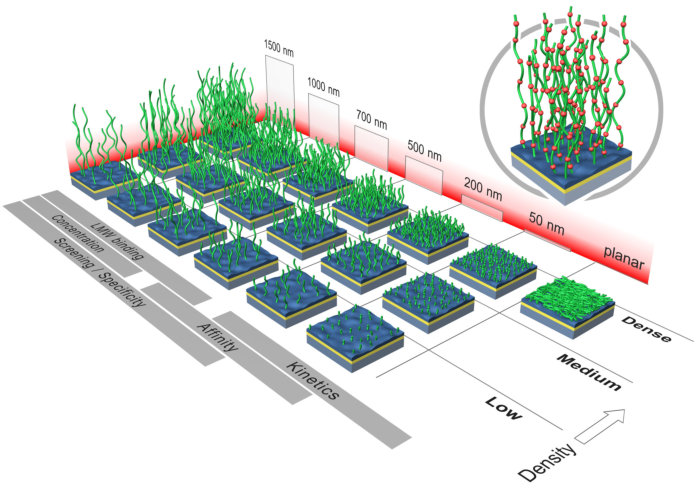Introduction
In this section we discuss the sensors (sensor chips) which are commonly used in SPR systems. Since the size and the format (square, rectangular, with a protective sheet or without) differ between manufacturers, here we will focus on sensor surfaces.
Although the optical configuration (to measure the signal) and the fluidics (to deliver the sample) are important, the sensor can be seen as the heart of an SPR instrument. Despite being a disposable object, the sensor is still a high precision part and should be handled accordingly. For instance, all dust particles, finger prints and moisture on either side of the sensor surface will distort the SPR measurements. Therefore, let the sensor come to room temperature when stored cold and handle with care (forceps).
Sensor chip can be roughly divided in four types:
- 2D planar-like surfaces
- 3D-like surfaces
- Inorganic surfaces
- Metal coatings
The sensors with 2D planar surfaces are virtually flat and the functionalisations are grafted directly on the gold layer. The 3D-like sensors have a matrix between the gold surface and the functionalisations. This will give more surface and capacity to bind compounds. Common matrices are dextran, alginate, agarose or poly-L-lysine (1), (2).
The dextran-based sensor chips of Biacore (Cytiva) vary the capacity by changing the percentage of carboxylation of the dextran. The capacity of the XanTec sensor chips is controlled by three parameters: i) spatial distance between the brush structured individual hydrogel chains, ii) hydrogel thickness via the chain length and iii) the charge density by the composition of the polycarbonates (1)
The density and thickness of the sensor surface should be optimized for the experiment. Use the info graphic below to make the best choice.

Both 2 and 3D can be functionalized with special inorganic binding groups such as carboxymethyl or NTA, or organic groups such as proteins or lipids.
Inorganic surfaces are overlaid over the gold plasmonic layer and can for instance be made of SiO2, TiO2, Al2O3, ITO, HfO2, ZnS, TiNO and are often used to test anti fouling systems.
When the metal itself is the surface it acts as the plasmonic of the sensor and can be used in studies of coating, corrosion, electrodeposition, electrode functionalization and others (3).
| Modification | Biacore | BioNavis | XanTec | Sofchip# |
|---|---|---|---|---|
| plain gold surface | Au | Au | Au | ✔ |
| no matrix, low capacity | C1 | CMDP | ✔ | |
| short matrix, low capacity | CMD-2D | |||
| short matrix, normal capacity | CM3 | CMD50, HC30 | ✔ | |
| normal matrix, low capacity | CM4 | CMD-3DL | HLCx | |
| normal matrix, normal capacity | CM5 | CMD-3DM | CMD200, 500, HC200 | |
| normal matrix, high capacity | CM7 | CMD-3DH | CMD500D, HC1500M | |
| poly HIS binding group | NTA | NID-2D, NID-3D | NiHC1000M | ✔ |
| hydrophobic surface | HPA | HPP | ||
| biotin capturing surface | SA | STR-2D, STR-3D | SADxx, SAHCx | ✔ |
| biotin capturing surface (regenerable) | CAP-kit | AVI-kit | ||
| biotin on surface | BT-2D, BT-3D | BDx | ||
| *) from manufacturers website - #) See website for ordering numbers | ||||
Keep in mind that the mentioned manufactures above all use their own technique to make the sensor chip and therefore it is difficult to compare the capacity of the sensor chip directly. On the site of Xantec more information is available about sensor chips.
| Sensor surface | Applications |
|---|---|
| Long chain dextran/carboxymethyl dextran/alginate | General purpose; suitable for protein-protein interactions and small molecule analytes |
| Short chain dextran/carboxymethyl dextran/alginate or planar SAMs | Suitable for protein-protein interactions and for large analyte molecules and particles |
| Immobilized (Strept)(Neu)(Extr)avidin | Capture of biotinylated ligands |
| Immobilized NTA | Capture of poly-histidine tagged ligands |
| Immobilized Protein A, G or L | Capture of IgG |
| Lipophilic modification | Capture of liposomes and supported lipid bilayers |
| Hydrophobic surface | Capture of lipid monolayers |
| Plain gold surface | Surface interaction studies and custom design of surface chemistry |
References
| (1) | XanTec - XanTec bioanalytics GmbH. (2022). Goto reference |
| (2) | Bio-Rad - ProteOn sensor chips - overview - bulletin 5404D. (2012). |
| (3) | BioNavis - BioNavis website. (2022). Goto reference |
| (4) | Sofchip - Sofchip website. (2022). Goto reference |
| (5) | Biacore / Cytiva - Biacore website. (2023). Goto reference |
Footnotes
- ProteOn XPR 36 is not sold any more. Sensor chips via Xantec and maintenance (2022) via BioSensortools